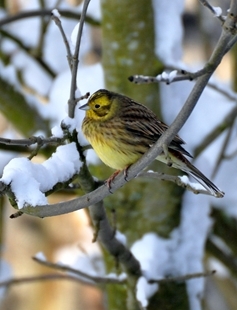 The weather might be soggy but the time has come to start counting those birds! The Game & Wildlife Conservation Trust’s (GWCT) third Big Farmland Bird Count (BFBC) will be taking place from 6-14 February 2016. The GWCT is encouraging all farmers and landowners to take part in the nationwide survey of our declining farmland birds.
The weather might be soggy but the time has come to start counting those birds! The Game & Wildlife Conservation Trust’s (GWCT) third Big Farmland Bird Count (BFBC) will be taking place from 6-14 February 2016. The GWCT is encouraging all farmers and landowners to take part in the nationwide survey of our declining farmland birds.
For the past fortnight, nearly 350 people across the UK have been taking part in the GWCT’s bird Identification Days, making sure their skills are up to scratch ready for the main event’s launch this weekend.
Jim Egan, Head of Training & Development at the GWCT, says: “With the third Big Farmland Bird Count fast approaching, we are inviting all farmers to grab their binoculars and their wellies and get counting! This is a great opportunity for farmers to just get out there and see what’s on their farm and which birds are using it in the winter months.
“Our research at the GWCT Allerton Project research farm demonstrates just how much can be done for farmland birds and how easy it can be to attract them. Simply adding nest boxes in and around your farm is an effective way of encouraging tree sparrows, having tall hedges and areas of scrub is perfect for bull finches, and yellowhammers enjoy grass margins next to dense hedges. Remember that the easiest way to attract all winter birds is just providing them with seed.”
Graham Hartwell from BASF, the main sponsor, says: “The excellent BFBC 2015 results highlighted the increasing numbers of farmers that are keen to show off the results of their consistent farm management to deliver improved habitats for farmland birds. BASF is delighted to again help UK farmers in their support of BFBC 2016 so that collectively BFBC can demonstrate UK farmers’ progress in proactive habitat and wildlife management.”
Taking part in the Count is simple. Just pick one day between 6-14 February 2016 and spend 30 minutes recording the species and number of birds seen on one area of land. Pick somewhere you know you’re likely to see some birds, such as an area of wild seed mix, somewhere you already spread seed to feed, or a field with a tall hedge and a good field margin.
You can choose your own location, but somewhere with a good view of around 2 ha of the farm would be ideal. Binoculars and note book will help with your count, and a hot coffee and blanket aren’t essential but you’ll be happy to have them in the February chill!
As Guy Smith, Vice President of NFU, says: “Don’t just be proud – be loud! Tell people about the birds you see.” So spread the news and see if you can count more birds than your friends and neighbours.
The BFBC is a fantastic opportunity to show how modern farming can support a vibrant and healthy countryside by applying simple targeted methods.
If you’re a farmer and would like to take part in the 2016 BFBC, the GWCT has several tools to help. Along with an ID guide there is a simple recording sheet, both of which can be downloaded from the GWCT’s website. Participants can then fill in their results on a dedicated web page.
If you took part last year, this is a great chance to participate again and see how numbers have changed. If you didn’t take part last year then this is your chance to find out what species are around!
If the excitement of learning just how many wild birds are on your land isn’t enough, remember that if you submit a completed count sheet online you will be entered into a prize draw to win a fantastic pair of Swarovski SLC 8x42 multipurpose binoculars worth £1,310, kindly donated by Swarovski Optik KG.
For more information or to download count forms, please visit: www.gwct.org.uk/BFBC or telephone: 01425 651000
Photo credit - Peter Thompson
Notes for editors:
The Game & Wildlife Conservation Trust – providing research-led conservation for a thriving countryside. The GWCT is an independent wildlife conservation charity which has carried out scientific research into Britain’s game and wildlife since the 1930s. We advise farmers and landowners on improving wildlife habitats. We employ 14 post-doctoral scientists and 50 other research staff with expertise in areas such as birds, insects, mammals, farming, fish and statistics. We undertake our own research as well as projects funded by contract and grant-aid from Government and private bodies.
* GWCT’s Big Farmland Bird Count is sponsored by the NFU and delivered in partnership with the Farmers Union of Wales, Ulster Farmers’ Union, NFU Cymru, NFU Scotland, Kings, CFE, FWAG, National Sheep Association, Camgrain, LEAF, the CLA and Perdix.
For information, contact:
Eleanor Williams
Telephone: 07592 025476